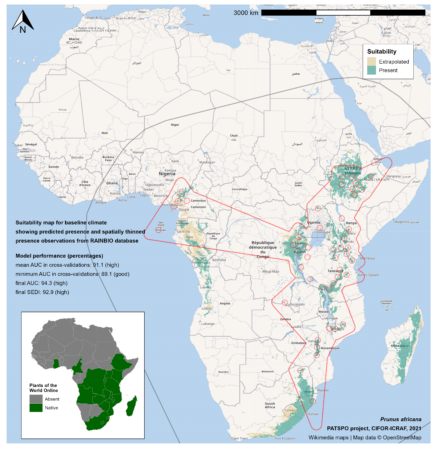- Drivers and stressors of resilience to food insecurity: evidence from 35 countries. Diversify!
- The input reduction principle of agroecology is wrong when it comes to mineral fertilizer use in sub-Saharan Africa. …but that doesn’t mean agroecology is wrong. So, diversify your mind?
- Genetic modification can improve crop yields — but stop overselling it. Diversify your research teams.
- Genomic predictions to leverage phenotypic data across genebanks. Diversify your training set.
- Harnessing plant resistance against Striga spp. parasitism in major cereal crops for enhanced crop production and food security in Sub-Saharan Africa: a review. Diversity within the weed is almost as important as diversity in host resistance, and less studied.
- Farmers’ heterogeneous preferences for traits of improved varieties: Informing demand-oriented crop breeding in Tanzania. Breeders need to take into account farmer diversity too.
- Farmer Risk Preferences and Willingness to Pay for African Rice Landrace Seed: An Experimental Choice Analysis. Farmers are willing to pay for diversity.
- Too simple, too complex, or just right? Advantages, challenges and resolutions for indicators of genetic diversity. What’s the best way to measure diversity anyway?
Nibbles: China seeds, Dixie apples, USDA genebanks, ASU dates, IPR, IFG grapes, Pick-a-mix, Coffee ESG, French heirlooms, Belgian brewing, Tanzanian sorghum, Horse-bread, Roots & tubers, Guyana cassava, SDG indicators
- China announces a slew of seed-related measures.
- A slew of seeds kept apples diverse in the US South, but not so much any more.
- Fortunately there’s a slew of apples, among many other things, in the USDA genebank system.
- Dates too, probably, but this article is actually about the (complementary?) collection at Arizona State University.
- A slew of intellectual protections has been good for seed companies. But consumers?
- IFG no doubts benefits mightily from intellectual property protection of its grape varieties. The diversity of which you can peruse on this nice website.
- Speaking of nice websites, this one helps farmers pick-a-mix of crops. Intercropping is diversity too.
- How the coffee industry is trying to cope with a slew of sustainability rules. Yeah, sometimes IP protection is not enough.
- But who owns heritage varieties?
- Including heritage varieties of Belgian malting barley and other cereals.
- Speaking of malting, they use sorghum in Tanzania.
- It’s unclear what heritage varieties went into making horse-bread, but I’d like to taste the stuff.
- But who needs bread (or beer?) anyway? There’s a slew of root and tuber crops in Africa and elsewhere just waiting to solve hunger…
- …as Guyana knows well.
- Wanna keep track of (most of) the above? FAO has you (sorta) covered via a slew of indicators.
Nibbles: Heirloom pean, Genebanks, Students, Community seedbanks, Kunming fund, Kenyan sorghum, Italian grapes, Wild tomatoes, Mouflon, Coffee poster, Early modern watermelons, Korean language, Farmers’ rights
- Why heirloom seeds matter.
- Why genebanks full of heirloom seeds matter. Even to kids.
- Why community seedbanks full of heirloom seeds matter.
- Just how much agrobiodiversity matters, according to FAO.
- Why heirloom seeds of neglected crops matter.
- Why heirloom seeds of sorghum matter in Kenya. No, really.
- Why heirloom grapes matter in Italy.
- Why seeds of wild tomatoes matter.
- Even wild sheep matter.
- Why visualizing coffee diversity matters.
- Why watermelons mattered in the 17th century.
- Why bottle gourds mattered to Koreans.
- Why farmers’ rights matter.
Trees everywhere
Our friends at World Agroforestry (the centre formerly known as ICRAF) have been very busy with their data wrangling in support of policy recommendations. So much so, in fact, that it may be getting complicated for outsiders to keep all their information products straight, so here’s a quick recap.
Let’s start with the premise that we need more trees. I don’t think anyone disputes that. The problem, as has been repeated many times now, is to have the right trees in the right places. That starts with the right seeds, of course. In a recent paper, World Agroforestry scientists and partners suggest that what we need for that is more transparency (and accountability) about where those seeds will be coming from.
But which species should be sourced? That’s where GlobalUsefulNativeTrees comes in. As described in another recent paper, this has data on “14,014 tree species that can be filtered for ten major use categories, across 242 countries and territories.” So if you want to know what trees can be used as animal food in tropical montane Kenya, say, this will tell you. The answer is Prunus africana, by the way.
Ah, but you may be worried about how the trees you have selected to plant (or indeed have already been planted) will do under climate change. Fear not, World Agroforestry again has you covered with TreeGOER. That has data on the climatic preferences of 48,129 tree species, and their likely vulnerability as the climate changes. The results may well send you back to GlobalUsefulNativeTrees for a rethink.
Hope that clarifies the tree data landscape a bit. Looking forward to other use cases from readers.
LATER: Oh, and there’s also a climate change atlas.
Nibbles: Kenyan maize, Plant ID, Ames genebank, Eating grass, Californian seeds
- The hidden history of ugali in Kenya. Unnecessary spoiler alert: colonialism is involved.
- An app for taxonomic identification. Unnecessary spoiler alert: AI is involved.
- The not-so-hidden history of the North Central Regional Plant Introduction Station at Ames, Iowa.
- Let them eat grass. No, man, species of the Poaceae. Possibly unnecessary spoiler alert: New Zealand is taking the lead.
- The silver lining of Californian storm clouds. Spoiler alert: seeds.
